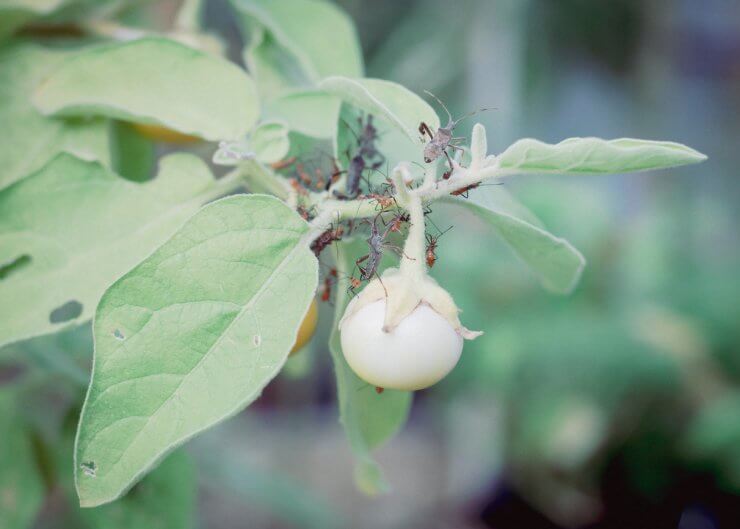
Stink bugs and leaf-footed damaging developing fruit of white eggplant
A couple notes about prevention:
- Don’t overwater.
- Use floating row covers when plants are young.
- Place sticky traps to catch pests early.
- Plant trap crops like marigolds that will attract them away from your plants
Spot the symptoms of eggplant pests
Check leaves, bulbs, and flowers for these symptoms that come from pests on the prowl.
On Eggplant Leaves
| Symptoms | Pest |
|---|---|
| Yellowing leaves; clusters of small “bumps” on leaves | Aphids |
| Eaten undersides of leaves, yellow spots, and leaf drop | Leafhoppers |
| Misshapen spots of mottled discoloration on the leaves | Eggplant lace bugs |
| Visible knots in roots when you check below the soil line; planting near Brassicas will help | Root knot nematode |
| Discolored trails on leaves | Leaf miners |
| Stunted or deformed, yellowing leaves | Whiteflies |
| Tiny holes in leaves | Flea beetles |
| Heavily chewed leaves; defoliation | Potato beetles |
| Chewed leaves and blossoms; may also bore into fruit | Hornworms |
| Discolored spot on skin of fruit | Stink bugs |
| Webs on leaves; damage to underside of leaves; white or yellow spots on leaves; leaf drop | Two-spotted spider mites |
| In warmer climates, these moth larvae start with small holes in leaves, stems and fruit, then leaves will fold | Tomato pinworm |
| Leaves become yellow, white, or brown and sometimes bronze, then fall off; fruit will be stunted or deformed | Melon thrips |
How to treat pests on eggplants
First be careful not to use broad-spectrum insecticides, because they can kill off natural predators of the above pests. Here are some proven ways to get rid of pests on your eggplant. Choose the best treatment for the type of pests invading your plants.
- Shake the plants. Bigger pests can be spotted with a little shaking. For example, leaf hoppers are hard to spot because they blend in with the leaves, but a little shake and they’ll disperse, giving you time to apply a neem oil solution which will prevent them from coming back.
- Pick off the bigger pests. Use your garden gloves to remove the pests by hand. After removal, destroy pests by drowning them in a bucket of soapy water or crushing them with your foot. Handpicking isn’t efficient or practical for very small pests but works well with larger pests like hornworms and potato beetles.
- Wipe the underside of the leaves if you see eggs. Potato beetles in particular can lay a tremendous number of eggs in a short time that are resistant to commercial sprays, so you’ll want to wipe down the underside of the leaves if you see eggs.
- Blast them. If you spot invaders like aphids, give them a good blast with the garden hose. Chances are good the neighborhood birds will notice and come eat your pests. Spider mites will do better with misting on the underside of the leaves which will attract beneficial predators.
- Apply insecticidal soap. Insecticidal soap is organic. The potassium salts in insecticidal soap help remove an insect’s protective waxes, causing destruction of insect membranes and killing them. Mix the soap with water to create your solution and apply directly to insects on any plants. While insecticidal soap is less apt to affect other organisms, certain plants might be sensitive to the soap and can suffer leaf burn.
- Apply horticultural oils. Combine plant- or petroleum-based oils with water to produce horticultural sprays. Neem oil, for instance, is derived from seed extracts of the neem plant. Oil-based sprays block an insect’s air holes, interfere with an insect’s metabolism, disrupt insect feeding, and inhibit insect growth. Like insecticidal soaps, horticultural oils can cause plant injury if not properly diluted.
- Make your own pest spray. You can make your own pest spray with benign materials. Mix 1 tablespoon of baking soda, 1/2 teaspoon of a mild dish detergent, and 2 1/2 tablespoons of olive oil in a gallon of water to make a solution that will repel all kinds of bugs, as well as a fungicide for blight and mildew on plant leaves. Shake it well in your bottle before spraying and repeat every week for it to be continuously effective.
- Diatomaceous Earth (DE). Sprinkle DE at base of plants and between plants. Many pests cannot cross over this barrier without dying because it dries out their protective shells.
- Soil solarization. Since some pests, like root-knot nematodes, live in the soil, along with many soil infections, it’s wise to solarize your soil by covering it with a clear tarp in the middle of the summer if an infestation does arise. Nematodes can live in your soil indefinitely until they are eradicated.
Do pests attack your eggplant every year? How do you handle removing them—and even preventing them in the first place? Please tell us how you treat your eggplants to avoid pests.


 Previous
Previous


Zone 10A: I have 4 large Black Beauty eggplant plants. First I had tiny green caterpillars for 3 months, then mealy bugs for the next 3 months. I stand there and squish them for 1 hour a day. UGH!!!
BUT, the 6″-8″ eggplants are delicious – not bitter.